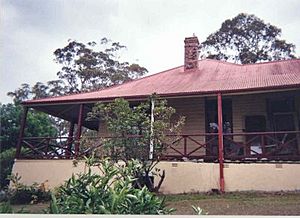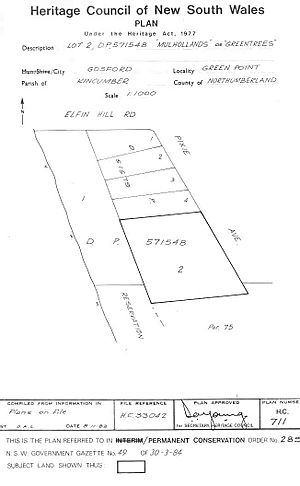Mulholland's Farm facts for kids
Quick facts for kids Mulholland's Farm |
|
|---|---|
 |
|
| Location | 9 Pixie Avenue, Green Point, Central Coast, New South Wales, Australia |
| Built | 1907 |
| Official name: Mulholland's Farm | |
| Type | state heritage (built) |
| Designated | 2 April 1999 |
| Reference no. | 289 |
| Type | Homestead building |
| Category | Residential buildings (private) |
| Lua error in Module:Location_map at line 420: attempt to index field 'wikibase' (a nil value). | |
Mulholland's Farm is a special old house located at 9 Pixie Avenue in Green Point, Australia. It was built in 1907. This farm is important because it shows us what life was like in the past. It was added to the New South Wales State Heritage Register on 2 April 1999, which means it's protected for future generations.
Contents
Discovering Mulholland's Farm History
The land where Mulholland's Farm stands has a long and interesting history. It was once part of two large pieces of land given out by the government in the 1830s. These were called "Crown land grants." Over time, these grants were bought, sold, and divided, eventually forming the farm we see today.
Early Land Owners and Grants
The first big land grant, about 640 acres, was given to Major Henry Smyth in 1839. He was a former leader of a penal colony. His land had a long edge along Brisbane Water. A main road between Gosford and Kincumber also crossed his property.
Smyth sold his land in 1847. It changed hands a few times before being bought by Carl Ludwig Sahl and John Nobbs in 1881.
The Green Point Estate Subdivision
In 1882, Carl Ludwig Sahl and John Nobbs divided Smyth's large land grant into 67 smaller pieces. This new area was called the "Green Point Estate." John Nobbs was a well-known person who helped start the Fruitgrowers' Union in New South Wales.
The estate offered different sized blocks of land, from 2 to 32 acres. All these blocks had access to a special wide road. There was also a government wharf area set up near the water.
The land was put up for sale in Sydney in 1882. The advertisements described the area as beautiful, with "magnificent scenery" and "unrivalled sites for Building purposes." They said it was great for fishing and hunting, with "Fish and Game abundant." The soil was rich, perfect for farming.
The advertisements also mentioned that the new railway between Sydney and Newcastle would make the property much more valuable. Steamers already traveled daily between Sydney and the area.
How Mulholland's Farm Began
Mulholland's Farmhouse is on a specific piece of land called Lot 1. This lot was bought by Charles Thomas Sandon and William Hume in 1891. Sandon later bought out Hume's share. He also bought the 100-foot strip of land along the water's edge, which was usually kept by the government. This meant the farm could have its own boat shed, wharf, and water system right on the water.
This property was sold again in 1892 to Eliza Sophia Winton. She sold it in 1907 to Herbert Henry Thompson, a farmer.
Thompson's Ownership and Building the Farmhouse
Herbert Henry Thompson was a farmer and orchardist living in Green Point. In 1902, he bought a 16-acre piece of land next to Lot 1. This land had been part of an earlier grant to Henry Linden in 1840.
When Thompson bought Lot 1 in 1907, he combined these two pieces of land. This created the property that became Mulholland's Farm. The current farmhouse was built across both these land pieces, so it must have been built after 1907. Thompson sold both properties to George James Mulholland in 1909.
The Mulholland Family Era (1909-1958)
It's not completely clear if Thompson built the farmhouse or if George J. Mulholland did. George Mulholland moved to Green Point from Wagga Wagga after buying the farm. He was part of a family known for successful farming.
Sadly, George Mulholland died in 1912. However, his wife, Cassie Wilson Mulholland, continued to live at and farm the property until she passed away in 1952.
By 1941, the farm had a house, cleared fields, a wharf, and a shed. It also had an irrigation system to water the orchards, with pipes, a pump, and a water tank. There was even a trolley track to load farm produce, though only parts of it remain today.
An oyster farm lease was active on the property from at least 1948. This meant the Mulhollands could grow oysters in Brisbane Water. Oyster farming was a big business in the area.
After Cassie Mulholland's death, the property was sold in 1958 to Gerald Robert and Lillian Bruce. They might have used the farm as a weekend home.
Changes and Suburban Growth
In 1961, the Bruces divided and sold off a large part of the farm. This made the property around the house much smaller, but it still included the water frontage. A new road, Pixie Avenue, was created.
The property was sold again in 1963 to Ellen Jones. She owned it until 1988, when Judith Ellen and John Ross Hazelton became the owners. Around this time, the property was no longer used as a farm. Garden plants were put in where the fields used to be.
In 1975, the 100-foot strip of land along the water was taken over by the local council to become a public park. This separated the wharf and boat shed from the house's land. In 1984, the remaining part of Mulholland's Farm was given a special protection order because of its historical importance.
Exploring Mulholland's Farmhouse
The farmhouse is a single-story building made of timber with weatherboard siding. It has a gable roof, which is a roof with two sloping sides that meet at a ridge. The roof is covered with corrugated metal.
A veranda wraps around the front and sides of the house, offering a nice outdoor space. There are two brick chimneys. At the back, there's a wing with the bathroom and kitchen. The veranda has a timber balustrade (a railing with posts).
Inside, the house has a wide central hallway with living and sleeping rooms on either side. The kitchen and bathroom are in the back corner. A garage is attached to the house. In front of the house, there's a concrete tank that was part of the old irrigation system for the farm.
The land around the house slopes down and is mostly clear. Some plants and trees are along the road and to the north of the house. There's also a water tank, a clothesline, a bird bath, and a concrete driveway.
Why Mulholland's Farm is Special
Mulholland's Farm is very important because it's one of the best examples of a farm from the 1880s to 1945 that still exists on Brisbane Water. It still has its original house (built around 1907), a wharf, and a boat shed. It also keeps its historic look and connection to the water.
The farm was added to the New South Wales State Heritage Register in 1999 for several reasons:
- It shows us history: The farm, even though it's smaller now, is one of the few old farms left from the 1880s subdivisions. It still looks like it did in the past, with its connection to the water and farm buildings. It also tells the story of the Mulholland family, who owned it for many years (1907-1958).
- It's a beautiful example of old architecture: The house is a great example of a simple country home from the early 1900s. Its design, with the veranda and weatherboard, was typical for farms back then. The wide central hallway was a popular feature of homes from that time. The house is also built in a great spot on a natural point of land.
- It's important to the community: Local people and the council see this house as a key part of the history of the Gosford and Wyong area. It's recognized as being important to the whole state of New South Wales.
- It can teach us more: Studying the house, jetty, and boat shed could reveal more details about how the farm was used in the past. The remains of the irrigation system are especially interesting for learning about old farm technology.
- It's rare and unique: The house, its verandas, and its location right on Brisbane Water are very special. The boat shed and parts of the old jetty show a clear link between the house and how people used Brisbane Water for transport or for businesses like oyster farming.


